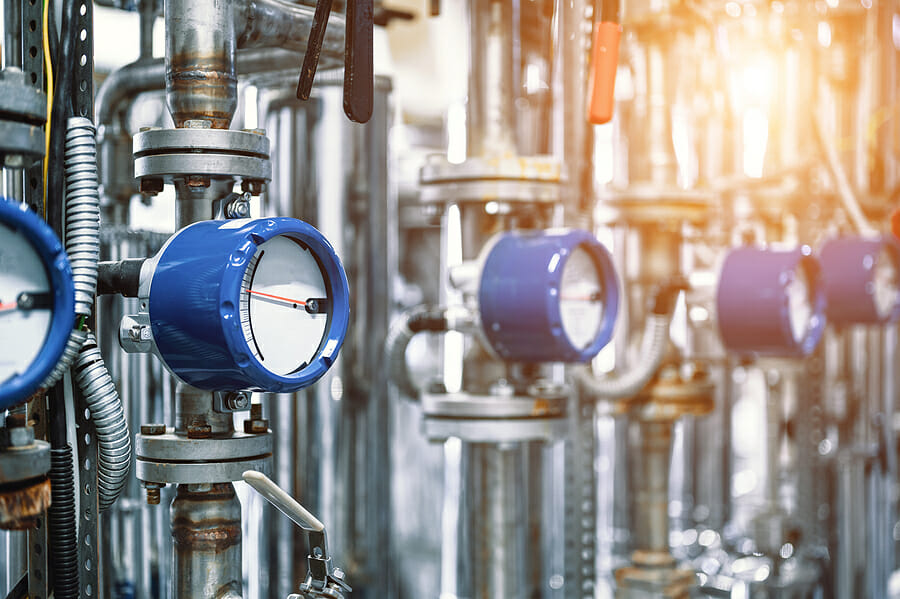Being able to accurately measure flow is an essential element of a wide variety of industries, from medical and pharmaceutical to oil, gas and wastewater treatment. With a number of different ways to measure flow using different technology, such as electromagnetic, vortex and mechanical, while such methods are traditional and very effective in certain applications, they aren’t the most effective option for every application.
For example, in some situations, using a more traditional tool that has moving or intrusive parts to measure flow, is not always desirable, since its techniques are invasive and not so long lasting. There are some instances in which a less invasive and longer lasting technique of measuring flow is beneficial, and the type of ultrasonic flowmeters designed by Coltraco perfectly fit the bill.
What are ultrasonic flow meters and how do they work?
Without the need to make contact with any of the contents of a pipe, an ultrasonic flowmeter uses sound waves to accurately measure flow. Attached internally or externally to a pipe, they transmit ultrasonic waves when activated, from one side to the other side of the meter, which, when collected and measured, can be used to precisely determine the flow.
While all flowmeters operate using the same guiding principle, there are several different types to choose from. Some ultrasonic flowmeters can be fed into the pipe, while others are attached inline, and some can even be attached to a pipe externally with the use of clamps. This type of meter is both non-invasive and non-destructive, and is referred to as a clamp-on flow transducer.
Operating with the use of sound waves, there are two main types of ultrasonic flowmeters: Doppler and transit-time, each of which operates slightly differently in the transmission and measuring of sound waves:
Doppler ultrasonic flowmeters – these flowmeters use the Doppler effect to calculate flow rate. By transmitting a sound wave that travels through the fluid, the flowmeter measures the way in which the wave reflects: when the fluid isn’t moving, the reflected sound’s frequency remains the same, but if the fluid isn’t still and is moving, the reflected wave frequency is different; this effect is called the Doppler effect.
Transit-time flowmeters – when using this particular type of flowmeter, ultrasonic waves move in diagonally opposing directions, with one signal being sent upstream in the pipe, while the other signal is sent moving downstream. To measure flow using this technique, the difference in time that it takes for the two signals to reach the opposing side, is calculated. Under conditions in which there is no flow of liquid, the measurements for transit-time will be exactly the same, whereas in conditions in which the fluid is flowing, the wave travelling upstream will do so at a slower rate than the wave travelling downstream.
Explore the benefits of ultrasonic flowmeters across medical, pharmaceutical, oil, gas, and wastewater treatment industries. This technology, utilizing sound waves for non-invasive, accurate flow measurement, offers advantages like no moving parts, easy maintenance, and high accuracy. Ideal for clean and impure liquids, it’s a versatile tool for enhancing operational efficiency. For those seeking precision in environmental monitoring, pairing ultrasonic flowmeters with the best EMF meter can optimize accuracy and safety in critical applications.
Working by transmitting and receiving ultrasound waves through a pipe that’s carrying a liquid, both of these types of flowmeters measure flow in the same way, but the Doppler flowmeters are able to measure liquids that contain impurities and particulates, while the other type of transit-time meters are usually only used for measuring liquids that are clean and which contain no particulates.
Both of these types of flowmeters have a great many advantages, but it is important to recognize that they aren’t always ideal for use in every application. With this in mind, a thorough understanding of the pros and cons of each option is essential if you’re to make a reasoned assessment of which type of ultrasonic flowmeter would best suit your needs within your particular industry.
What are the advantages of using ultrasonic flowmeters?
Extremely useful in many different industries and across a wide range of applications, ultrasonic flowmeters have a number of advantages, the most popular of which can be found below:
- They don’t have any moving parts
Using moving parts that act as mechanical sensors, traditional flowmeters can be problematic in certain applications, since they have a tendency to obstruct normal flow and can even cause a loss of pressure. Additionally, the moving parts of a traditional flowmeter can degrade significantly over time, meaning that they often need to be repaired or replaced, and offer up results that aren’t as accurate. Using an ultrasonic flowmeter eliminates the worry of degradation or blockages (or both) as there are no moving parts involved at all.
- They are easy to maintain
Without any moving parts, as discussed above, ultrasonic flowmeters require minimal maintenance and have a much longer lifespan. Also, because they use a lot less power, they can keep performing successfully for a good number of years before requiring replacement batteries.
- They have both digital and analog options
Available in a wide range of outputs, the advanced technology of ultrasonic flowmeters has enabled ultrasonic transducers to be created that give digital readouts, and have capabilities for network connection. What advantage does this give? Transducers are able to communicate all of their measurements to a central monitoring system, and in real time.
- They are highly accurate
Provided the flowmeter has been mounted properly and installed correctly, they give extremely accurate readings, although it’s worth mentioning that clamp-on ultrasonic flowmeters tend to be less accurate than inline and insertion ultrasonic flowmeters.
Should the quality of the pipe be inferior, however, ultrasonic flowmeters will often be mounted internally, whereas if the quality of the pipe is good enough, clamp-on ultrasonic meters can be used instead.
What are the disadvantages of using ultrasonic flowmeters?
There are a couple of issues associated with ultrasonic flowmeters that it’s also important to be aware of when making your choice:
- They cost more upfront
Depending on your budgetary restrictions, you may find that an ultrasonic flowmeter is too expensive when compared to other inline flowmeters that you can buy. Mainly due to the cost of the acoustic parts, ultrasonic flowmeters do require a more substantial investment, but it’s worth keeping in mind that they offer many long-term benefits that may make your initial investment worthwhile.
- They can’t be used for all types of liquid
If you’re dealing with slurry, for example, or liquids that are highly contaminated, such a flowmeter may not be capable of measuring the flow accurately since that liquid is incapable of passing ultrasonic energy.
Also worthy of note, is the fact that when ultrasonic flowmeters are installed internally within a pipe, they simply cannot offer the same advantages in terms of saving money on maintenance, that a clamp-on ultrasonic flowmeter can. Any flowmeter installed within a pipe will need a lot of fixing and adjusting, and this means having to cut into pipes, something which could put a halt on production.
Let’s take a closer look at the advantages of clamp-on ultrasonic flowmeters
Able to be attached to a pipe externally, the clamp-on options are incredibly useful for a wide variety of applications, and not having to install a flowmeter inside a pipe offers the following advantages:
- There is no cutting of the pipe required
With it not being necessary to install a clamp-on ultrasonic transducer inside a pie, there is subsequently no cutting required, and the pipes can remain functioning with no interruptions to the process. Pipe cutting isn’t just inconvenient, but can also lead to damage and leaks, both of which can have a significant impact on product quality and the cost of maintenance.
- Flow is not obstructed
Anything being installed internally inside a pipe can cause problems, and if a more viscous fluid is being used, it can disrupt the flow and over time, trap particles and cause them to build up. an ultrasonic flowmeter installed on the outside of a pipe avoids this issue altogether.
- There is no loss of pressure
Without the need to come into contact with the fluid in question, ultrasonic flowmeters create no potential for a loss of pressure resulting from their installation or usage.
- There is no contact with the fluid
Many issues can arise when a traditional flowmeter – that must be in contact with the fluid – is used, which has the potential to cause pollution or degradation to the fluid passing through the pipe. This can be a common and not insignificant problem for applications within the food, medical and chemical industry. Not only that, but if a chemically or physically aggressive fluid is being carried through a pipe, a traditional flowmeter can face much faster degradation, and need to be replaced more often. Without making any contact with such a substance, clamp-on flowmeters reduce this risk significantly.
- They require minimal maintenance
Without any parts that move, and zero contact with harmful substances, clamp-on flowmeters have a much longer lifespan and require minimal maintenance when used correctly. Additionally, it’s worth noting that because these meters aren’t installed within a pipe, if they need to be serviced, this can quickly and easily take place without the need to shut down production or cut open a pipe.
Now let’s look at the disadvantages of clamp-on ultrasonic flowmeters
There are some disadvantages of this type of flowmeter that are worth considering:
- Only high quality pipes are applicable
The pipe that the clamp-on ultrasonic flowmeter will be attached to must be in good condition, and this type of meter won’t function on a pipe that is either made of, or contains, cement or concrete. Rust can also have dire consequences for these meters, with even a small amount able to negatively impact the accuracy of results.
- There is a reduction in accuracy
Ultrasonic flowmeters that measure a substance directly i.e. are inside a pipe, tend to have more accurate results than clamp-on meters. While they are still able to give accurate results, and aren’t as likely to be negatively impacted by wear and tear caused by the liquids within the pipe, even a slightly lower level of accuracy may not be acceptable for certain operations.
For the majority of operations in a wide range of applications, the advantages of clamp-on ultrasonic flowmeters are far greater than the disadvantages presented by more traditional flowmeters, but it’s important to be aware of everything mentioned here before making any decisions.
Image Source: BigStockPhoto.com (Licensed)
Site Disclaimer
The Content in this post and on this site is for informational and entertainment purposes only. You should not construe any such information or other material as legal, tax, investment, financial, or other advice. Nothing contained on our Site constitutes a solicitation, recommendation, endorsement, or offer by HII or any third party service provider to buy or sell any securities or other financial instruments.
Nothing in this post or on this site constitutes professional and/or financial advice. You alone assume the sole responsibility of evaluating the merits and risks associated with the use of any information or other content in this post or on this site.
You recognize that when making investments, an investor may get back less than the amount invested. Information on past performance, where given, is not necessarily a guide to future performance.
Related Categories: Tools, Reviews







